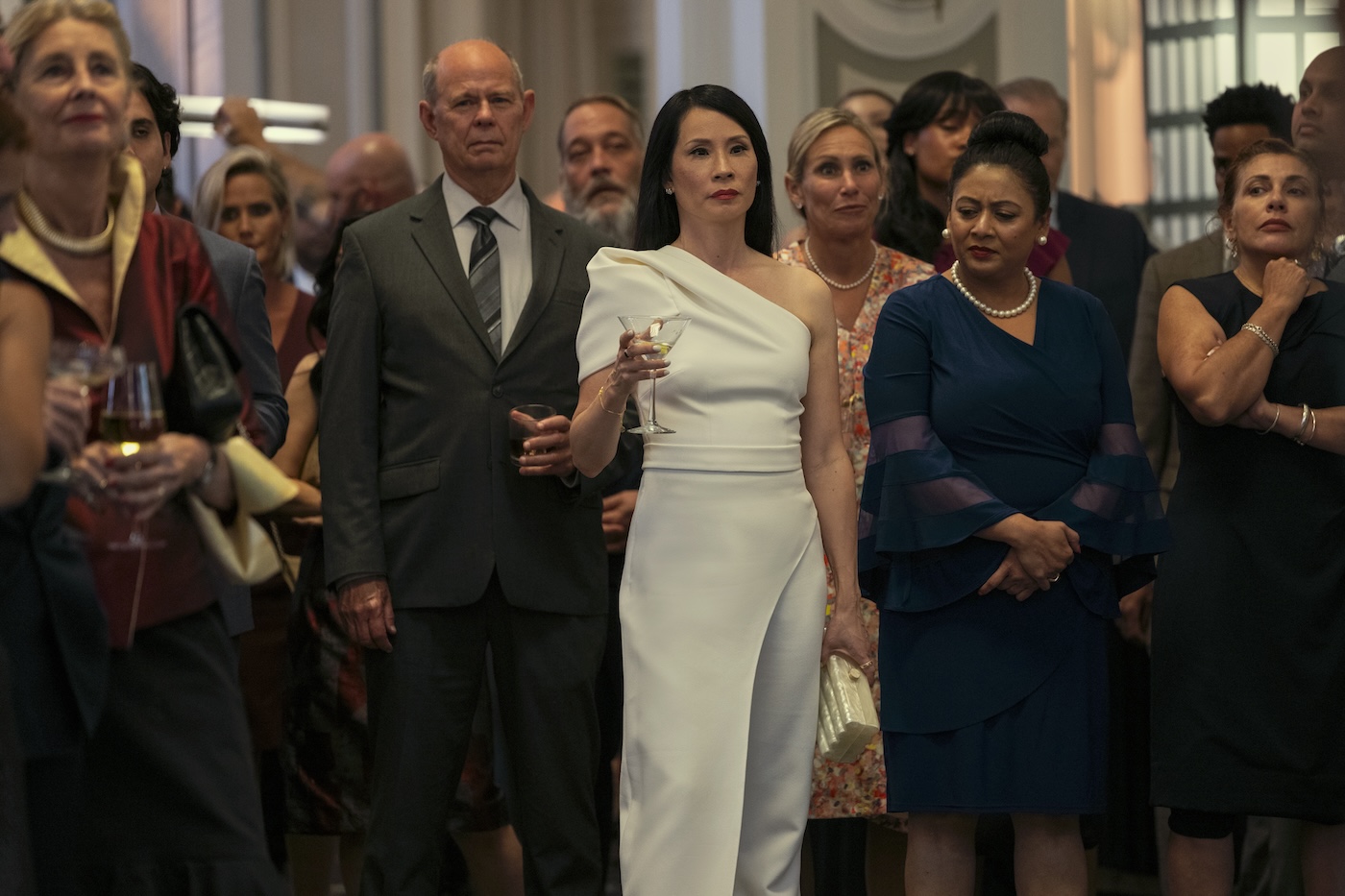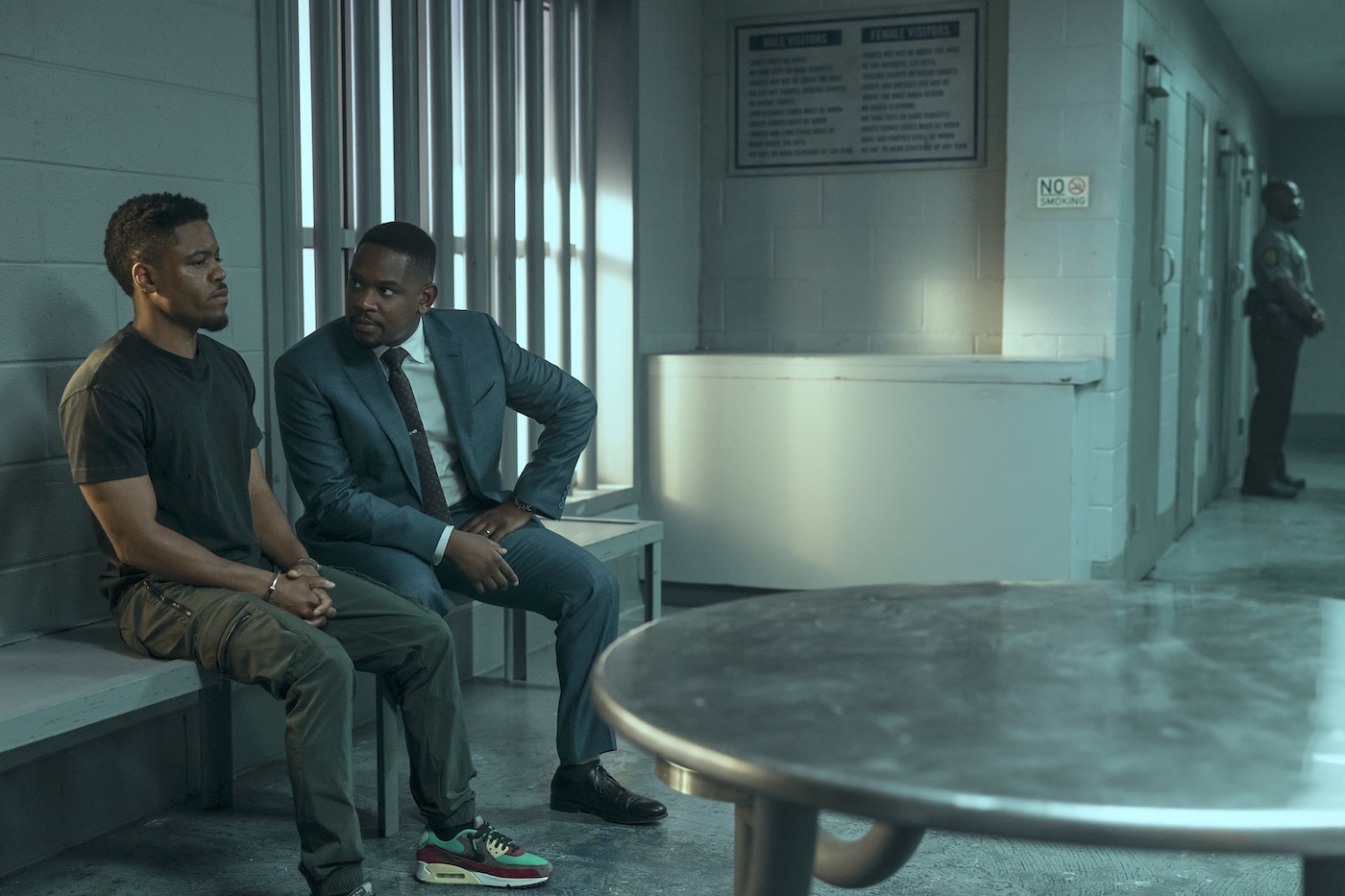Netflix’s dramatic series, A Man in Full (based on Tom Wolfe’s 1998 novel), is a tale of Atlanta society – top to bottom and back again.
by Margot Lester / Photos by Mark Hill / Netflix / Framgrabs Courtesy of Netflix
Netflix’s A Man in Full, based on novelist Tom Wolfe’s late 1990s bestseller, tells the story of Atlanta real estate mogul Charlie Croker’s (Jeff Daniels) struggle to save his empire and his reputation – while fending off opportunists hoping to capitalize on his sudden bankruptcy. As Director of Photography Tobie Marier Robitaille, CSC, describes: “When I read the script, I knew it had to be filmed in a way that felt realistic and believable.” To that end, Robitaille collaborated closely with Executive Producer/Director Regina King to create the visual language in the show’s pilot episode.
Robitaille says he and King’s goal was “to create an authentic world where camera movements were motivated by the actors’ actions, not the other way around,” he adds. “If there was glamor, it had to emanate from the opulent world of Charlie, rather than from elaborate camera work or lighting. We agreed to embrace imperfections; an image that’s too polished or perfect can sometimes overshadow the story, and that’s something we wanted to avoid. Additionally, we made great use of in-camera zoom-ins for specific scenes, always at pivotal moments in a character’s dramatic arc.”
The pair shot the pilot and the finale together. Of the Oscar-, Emmy-, and Golden Globe-winning actress-turned-director, Robitaille says: “Regina has this amazing ability to bring out the best in everyone around her. She creates a supportive atmosphere where everyone feels valued and inspired to do their best work. She’s one of the greatest human beings I’ve ever met and an incredibly collaborative director.”
Tommy Schlamme directed the remaining three episodes with Craig Wrobleski, ASC, CSC. (Schlamme had also worked with the same two cinematographers on Under the Banner of Heaven.) Wrobleski likens the look of the show to a heightened documentary style. “Everyone is, in some way, playing or has played a role in Charlie’s narrative, and there is a performative element to all their personalities, as well as a transactional aspect to all their relationships,” the Calgary-based filmmaker points out. “It felt like the cinematography should capture that heightened world in a way that was natural and unobtrusive but, in itself, heightened in proportion to the ‘reality’ of their world. Shooting 2.40 anamorphic, a choice made by Regina and Tobie, felt like a perfect match. It is a format that is equally powerful in both epic wide shots and intimate close-ups.”

To bring Creator/Showrunner David E. Kelly’s vision to life, the crew had to rely on camera innovations, advanced display technology, and on-set ingenuity. Robitaille chose the new (at the time) 24-V ALEXA 35. “I’ve always liked the look of Super 35,” he explains. “I don’t see it as an inferior format compared to bigger ones, and I believed it was perfect for A Man in Full.” First AC Matt Heath was equally excited to use the ALEXA 35. “It opened up an avenue to use older, unexpanded lenses that were not compatible with our newly adopted large-format sensors,” Heath explains. “Overall, it’s a fantastic camera with impressive features, such as left side display, articulating EVF bracket, and an abundance of power accessory ports.”
But there was one question: Would the first ALEXA 35 cameras off the shelf arrive in time to do camera tests and establish the LUT’s? The answer was “barely,” with a body arriving just a few days before filming commenced. “All of this happened within a very short timeframe because we couldn’t begin working without the camera in our hands,” Robitaille laughs. “Panavision [Atlanta] really came through.”
Heath adds that the ALEXA 35 offered a new base design and none of the few SAM-7 plates were available. “Thankfully, we were able to have Ian Ruppieko at Panavision Atlanta machine-fabricate one so we could shoot Steadicam day one,” Heath shares.
Panavision also made a 24-V power cable to enable Steadicam Operator Tim Fabrizio, SOC, to power the camera from his sled. The crew carried an ARRI remote head full time, too, operated and maintained by Sebastian Lumme. Panavision outfitted the ALEXA 35 with two C Series anamorphic lens kits and a custom 40-mm close-focus lens crafted by Dan Sasaki, the company’s senior vice president of optical engineering and lens strategy, based in Los Angeles. After initial emails and phone conversations with the DP’s about the look and language, Sasaki got down to designing the bespoke glass.

“We’ve been customizing lenses on the ALEXA 35 since the camera’s inception, starting as early as with Robert Richardson, ASC, on Air,” Sasaki recounts. “A Man in Full was particularly interesting because it allowed us to mix anamorphic and spherical and to explore giving our C Series lenses a closer focus and more vintage feel. We modified the way the lenses flared and brought the close focus in for a couple of focal lengths.”
The result was a different look in terms of close focus, field roll-off and flaring characteristics. Sasaki also fashioned the spherical Primo lenses to match the modified C Series for backup. “The Primo modifications resulted in a softer version of a stock lens, bridging the qualities of the two series in a way that would make the transition between them as seamless as possible,” Sasaki adds.
Nestled in an unpainted silver housing, the crew dubbed the custom lens “The Silver Fox, which,” Wrobleski laughs, “I’m told was also a reference to my rapidly graying hair. Older anamorphics tend to have limitations when it comes to close focus, which can force you to use longer lenses for the close-up work.”
The Silver Fox enabled up-close-and-personal access while maintaining the aesthetic, as seen in Episode 102, when Charlie meets with an orthopedist about a knee replacement. “Charlie’s becoming a little unhinged at this point, and there’s a shot where he demands a new knee,” Wrobleksi adds. “Jeff played it where he leaned forward and down toward the desk, so we shot a special close-up on the Silver Fox. Jeff becomes very dominant in the frame – feeling uncomfortably close to the camera – and a desk lamp flares in a way that feels like a visual representation of his state of mind.”

Another sequence showcasing the gear’s capabilities occurs in Episode 2 when Charlie learns of the bank’s intention to shutter his business. “It isn’t a showy scene or technical tour de force,” Wrobleski continues. “It’s essentially a group of characters around a boardroom table – but it embodies the themes of power and interpersonal dynamics that Tommy and I were leaning into for our episodes.”
Wrobleski says he and Schlamme didn’t want to shoot it in conventional matching coverage. “So, we worked with the operators [A-Camera] Tim Fabrizio and [B-Camera] Chris Arata, to challenge and scrutinize every setup to ensure we were making the best use of the tools of lensing, camera distance and height, and composition to put the audience in the middle of the power struggle,” he adds. “It’s a heavy dialogue scene, but my hope is that you could watch it without sound and still understand the power struggle and how the dynamic shifts.”
A Man in Full was the latest production to use an LED Volume. Production Designer David Bomba [ICG Magazine June/July 2020] created the quintessential executive office for Charlie, including the requisite wall of windows showcasing the Atlanta skyline. It had everything except an actual view.
“While the first thought was to use a backdrop, I couldn’t quite bring myself to go that route,” Robitaille recounts. “So I proposed the idea of using a Volume LED wall. With no time to create a 3D environment in Unreal Engine, we opted to shoot plates that could be projected onto an LED volume wall. Since we’d be filming in this set for several days per block, it offered far more creative potential and flexibility. It’s the only way to truly capture how light interacts with and reflects off the set as it would in real life.”
To enhance the authenticity, Bomba added more reflective surfaces to the set, and Light Iron Colorist Ian Vertovec graded the content without the show LUT, choosing instead a perceptually objective Display Reference Transform to enable the widest spectrum possible for secondary capture and light-source emission. Vertovec, King and Robitaille had developed a base LUT off of hair and makeup tests in prep. Then Vertovec used Baselight for final color and Lattice for adjusting and testing exported show LUT’s. “I always make sure to have an honest conversation about middle gray – keeping it as close to neutral as possible, unless we’ve explicitly decided for the LUT to push or pull the effective ISO of the camera,” explains Vertovec, who worked with King on One Night in Miami [ICG Magazine Deep Dive #5] and Wrobleski on Tales From the Loop.

Vertovec takes the same approach to color temperature unless decided otherwise. “It can be tempting to grade some test footage into a nice place and want to use that for a show LUT,” Vertovec continues. “But you could be baking-in something that won’t work for every scene. Keeping middle gray neutral means the DP can rely on camera metadata ISO and Kelvin for what is getting recorded to RAW, even though the output image is going through a show LUT.”
The Volume’s functionality was most useful in the pilot episode, which features an intense sequence between Coker and his assistant Jill Hensley (Chanté Adams). As Robitaille describes: “We captured a stunning plate at dusk, with ominous dark clouds, but there was an obvious gap on the horizon where a vibrant orange sunset was breaking through. It’s a prime example of how this technology enables us to achieve truly realistic cinematography. With this setup, not only do you get this endless sunset effect, but when you observe all the reflections on the set, it looks incredibly lifelike. You just can’t achieve that level of realism using green screens or backdrops.”
The series was Wrobleski’s first production in the ATL. As he recalls: “The crew was one of the most wonderful I had ever collaborated with. Southern hospitality is real, and everyone went out of their way to make me feel welcome and to help immerse me in the world of A Man in Full. Not only are they professionals of the highest order, but they are also all incredible human beings who gathered around me like a family when I was facing some personal challenges during prep and the shoot. Their kindness and generosity is something I will never forget. It’s different in every city, but the built-in common ground of everyone being a filmmaker means we are never strangers for long.”


Directors of Photography: Tobie Marier Robitaille, CSC, Craig Wrobleski, ASC, CSC
A-Camera Operator/Steadicam: Tim Fabrizio, SOC
A-Camera 1st AC: Matt Heath
A-Camera 2nd AC: Mike Fitzgerald
B-Camera Operator: Chris Arata
B-Camera 1st AC: John Metcalfe
B-Camera 2nd AC: Becca Bennett
DIT: Ted Viola
Loaders: Cory Blake, Danna Garcia
Utilities: Ashley Hedges, Bala Maji
Stabilized Head Tech: Sebastian Lumme
Unit Still Photographer: Mark Hill
Unit Publicist: Denise Godoy
